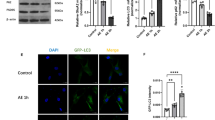Abstract
Sevoflurane, one of the most commonly used volatile anesthetics in clinical treatment, has been shown to induce a widespread increase in brain apoptosis. However, the underlying mechanism is still unknown. Sestrin 2 has been recently shown to regulate intracellular reactive oxygen species (ROS) levels and play a crucial role in p53-dependent antioxidant defenses. In this study, our results indicated that administration of Sevoflurane elevated the gene and protein expression of Sestrin-2 in a dose dependent manner in human neuroblastoma M17 cells. It was shown that silence of Sestrin-2 by small RNA interference (siRNA) ominously exacerbated the increase in intracellular ROS and reduction of SOD activity induced by Sevoflurane treatment. Notably, knockdown of Sestrin-2 in M17 cells significantly increases the number of apoptotic cells after treatment with Sevoflurane. Mechanistically, we also found that Sevoflurane treatment resulted in a reduced amount of the cytosolic anti-apoptotic protein Bcl-2 but an increased amount of Bax, which was exacerbated by knockdown of Sestrin-2. In addition, knockdown of Sestrin-2 remarkably increased the elevated cleaved Caspase-3 expression. Finally, we showed that the induction of Sestrin-2 by Sevoflurane was mediated by p53. These results suggest that the suppressive effects of Sestrin-2 on neuroapoptosis against the Sevoflurane anesthesia in neuronal cells might be associated with modulation of mitochondrial pathway.







Similar content being viewed by others
References
Alkire MT, Gruver R, Miller J, McReynolds JR, Hahn EL et al (2008) Neuroimaging analysis of an anesthetic gas that blocks human emotional memory. Proc Natl Acad Sci U S A 105:1722–1727
Brambrink AM, Evers AS, Avidan MS, Farber NB, Smith DJ, Zhang X et al (2010) Isoflurane-induced neuroapoptosis in the neonatal rhesus macaque brain. Anesthesiology 112(4):834–841
Budanov AV, Karin M (2008) p53 target genes sestrin1 and sestrin2 connect genotoxic stress and mTOR signaling. Cell 134:451–460
Budanov AV, Shoshani T, Faerman A et al (2002) Identification of a novel stress-responsive gene Hi95 involved in regulation of cell viability. Oncogene 21:6017–6031
Budanov AV, Sablina AA, Feinstein E, Koonin EV, Chumakov PM (2004) Regeneration of peroxiredoxins by p53-regulated sestrins, homologs of bacterial AhpD. Science 304(5670):596–600
Chen G, Gong M, Yan M, Zhang X (2013) Sevoflurane induces endoplasmic reticulum stress mediated apoptosis in hippocampal neurons of aging rats. PLoS One 8(2), e57870
Fanselow MS (2000) Contextual fear, gestalt memories, and the hippocampus. Behav Brain Res 110(1–2):73–81
Jevtovic-Todorovic V, Hartman RE, Izumi Y, Benshoff ND, Dikranian K, Zorumski CF et al (2003) Early exposure to common anesthetic agents causes widespread neurodegeneration in the developing rat brain and persistent learning deficits. J Neurosci 23(3):876–882
Kvolik S, Glavas-Obrovac L, Bares V, Karner I (2005) Effects of inhalation anesthetics halothane, sevoflurane, and isoflurane on human cell lines. Life Sci 77:2369–2383
Kvolik S, Dobrosevic B, Marczi S, Prlic L, Glavas-Obrovac L (2009) Different apoptosis ratios and gene expressions in two human cell lines after sevoflurane anaesthesia. Acta Anaesthesiol Scand 53(9):1192–1199
Lee JH, Budanov AV, Karin M (2013) Sestrins orchestrate cellular metabolism to attenuate aging. Cell Metab 18(6):792–801
Liang H, Gu MN, Yang CX, Wang HB, Wen XJ, Zhou QL (2011) Sevoflurane inhibits proliferation, induces apoptosis, and blocks cell cycle progression of lung carcinoma cells. Asian Pac J Cancer Prev 12(12):3415–3420
Papadia S, Soriano FX, Léveillé F et al (2008) Synaptic NMDA receptor activity boosts intrinsic antioxidant defenses. Nat Neurosci 11(4):476–487
Satomoto M, Satoh Y, Terui K et al (2009) Neonatal exposure to Sevoflurane induces abnormal social behaviors and deficits in fear conditioning in mice. Anesthesiology 110:628–637
Sheng B, Gong K, Niu Y, Liu L, Yan Y, Lu G, Zhang L, Hu M, Zhao N, Zhang X, Tang P, Gong Y (2009) Inhibition of gamma-secretase activity reduces Abeta production, reduces oxidative stress, increases mitochondrial activity and leads to reduced vulnerability to apoptosis: implications for the treatment of Alzheimer’s disease. Free Radic Biol Med 46(10):1362–1375
Wang WY, Yang R, Hu SF, Wang H, Ma ZW, Lu Y (2013) N-stearoyl-L-tyrosine ameliorates sevoflurane induced neuroapoptosis via MEK/ERK1/2 MAPK signaling pathway in the developing brain. Neurosci Lett 541:167–172
Zhang Y, Dong Y, Wu X, Lu Y, Xu Z, Knapp A, Yue Y, Xu T, Xie Z (2010) The mitochondrial pathway of anesthetic isoflurane-induced apoptosis. J Biol Chem 285:4025–4037
Zhou F, Zhang L, Gong K, Lu G, Sheng B, Wang A, Zhao N, Zhang X, Gong Y (2008) LEF-1 activates the transcription of E2F1. Biochem Biophys Res Commun 365(1):149–153
Acknowledgements
Natural Science Foundation of Shandong Province (Studies on Anesthesia Expert Decision Support System, ZR2009CM098).
Author information
Authors and Affiliations
Corresponding author
Rights and permissions
About this article
Cite this article
Yi, W., Zhang, Y., Guo, Y. et al. Elevation of Sestrin-2 expression attenuates Sevoflurane induced neurotoxicity. Metab Brain Dis 30, 1161–1166 (2015). https://doi.org/10.1007/s11011-015-9673-1
Received:
Accepted:
Published:
Issue Date:
DOI: https://doi.org/10.1007/s11011-015-9673-1




